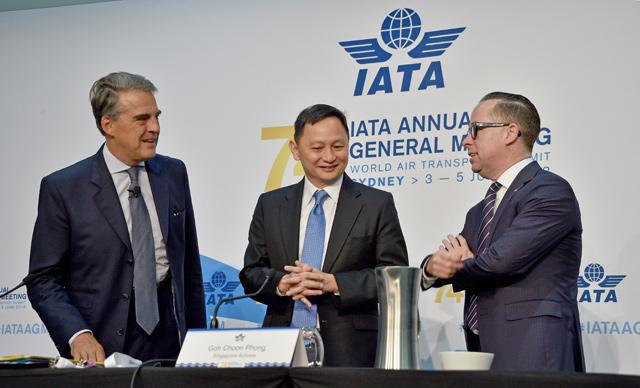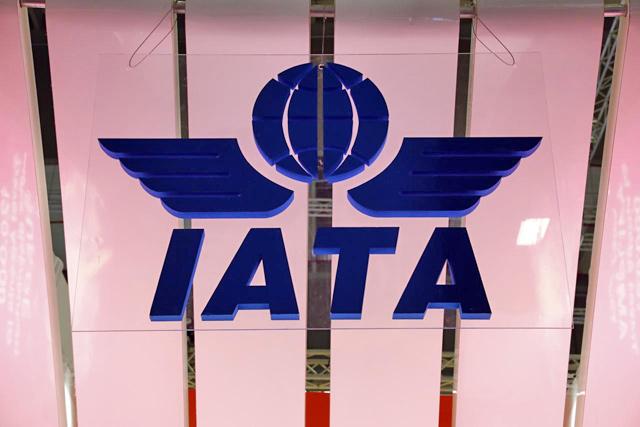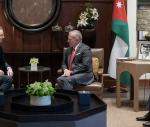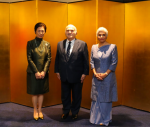You are here
IATA says 2018 promising for aviation industry
By Ica Wahbeh - Jun 04,2018 - Last updated at Jun 04,2018

International Air Transport Association (IATA) Chief Executive Alexandre de Juniac (left), Singapore Airlines Chief Executive Goh Choon Phong (centre), and Qantas Chief Executive Alan Joyce talk before a press conference at the annual meeting of global airlines in Sydney on Monday (AFP photo)
SYDNEY, Australia — Middle Eastern airlines are witnessing recovery and their net profit is forecast to reach $1.3 billion in 2018, up from $1 billion in 2017, according to the International Air Transport Association (IATA).
At its 74th Annual General Meeting held in Sydney this week, IATA said it expected airlines to achieve a collective net profit of $33.8 billion.
The June 3-5 meeting brings together over 1,000 industry and media people, reflecting its importance to the aviation industry.
Speaking at the plenary meeting, IATA Director General and CEO Alexandre de Juniac said the future of aviation “overflows” with opportunities, but it is becoming more difficult to make predictions about the direction global affairs evolve in.
Globalisation has had an undeniable positive impact, he said, as 1.1 billion people have been lifted from poverty, the world is growing richer and trade, empowered by connectivity, is a leading force in development.
Also, there are aspects that may negatively impact the industry, in addition to world developments, such as stronger protectionism, sanctions, tariffs, geopolitical conflicts, migration and immigration debates and the spectre of a trade war in an environment of an increasingly fragile trust among nations, he added.
Still, “aviation has created immense value by bringing people, products and businesses together. And ultimately, I believe that the enormous benefits of globalisation will guide us forward”, said de Juniac.
At least for now, the industry seems to indeed be going forward.
Despite rising costs, primarily of fuel and labour, and the upturn in the interest rate cycle, airlines are still expected to make over $33 billion this year, said the IATA chief, citing the 2018 IATA economic performance of the airline industry mid-year report.
“Our nine-year run of profitability began in 2010. And return on invested capital will exceed the cost of capital for four years in a row. At long last, normal profits are becoming normal,” said de Juniac.
Return on invested capital is expected to be 8.5 per cent (down from 9 per cent in 2017); that will still exceed the average cost of capital, which rose to 7.7 per cent on higher bond yields, from 7.1 per cent in 2017, and is critical to attracting “the substantial capital needed by the industry to expand its fleet and services”.
There are challenges, of course, said de Juniac, mentioning high taxes, costly and “ill-conceived” regulation, infrastructure capacity constraints, market shifts and labour demands.
Added to these is also competition from low-cost airlines and protectionism, which “could derail successful international joint ventures”, besides jet fuel prices, which are expected to be up 25 per cent over last year’s.
Still, airlines continued to “create value for investors in 2017, in most regions”, according to Brian Pearce, IATA chief economist, in his mid-2018 update on the economic performance of the airline industry, and for the third year running, the return on capital for the industry was above the cost of capital.
Performance was strong in North America and Europe. Latin American and Asian airlines were generating returns above the industry average cost of capital, but Middle Eastern airlines were lagging behind the rest of the industry.
It is not necessarily the case with Royal Jordanian.
Its President/CEO Stephan Pichler said: “We had a very good performance in the Q2 and Q3” of last year, which saw the airline register gains.
The company, which set a five-year turnaround plan, cut some of its costs, saving about JD6 million. It cancelled some non-viable flights, and achieved an equal amount of saving, and had good revenues, which could help it boast “a much better commercial performance” and has “allowed us to stabilise in the last year”, he noted.
In the first quarter of this year the trend continues, according to Pichler.
So far, the company recorded 18 per cent more revenue “while we offered only 4 per cent more seats”, RJ’s CEO told The Jordan Times.
“As far as we see, in the second quarter the trend continues. We hope to have a good 2018.”
Related Articles
GENEVA, Switzerland — The International Air Transport Association (IATA) forecasts global aviation net profit to increase by around 11
Geneva — Airlines are expected to earn $35.6 billion this year, “a record profit”, even if slightly less than original expectations, IATA Di
GENEVA — The International Air Transport Association (IATA) forecasts the global airline industry net profit to be $35.5 billion in 2019, sl

















